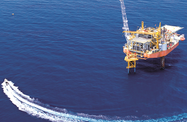Meeting energy demand and expanding electricity distribution networks will be among the greatest challenges for the Myanmar government over the coming years, as the country strives to keep the promises it made to citizens and the international community. With rich sources of hydroelectric power and new gas and oil blocks being tendered in 2013, there is indeed potential for growth.
About 70% of the population still relies on biomass as their primary source of fuel, according to the International Energy Agency (IEA) in 2009, and the country ranks next to Nepal in terms of per-capita energy consumption in Asia. As the poorest country in the ASEAN in terms of per-capita GDP, and with an electrification level of just 26%, Myanmar has a long way to go if it wants to match its neighbours, such as Thailand, where almost 100% of citizens have access to electricity.
Following biomass, natural gas accounts for 18.2% of energy supply, oil takes 8.5% of the market, while coal and hydropower account for 0.9% and 2.4%, respectively. However, these shares are expected to change as coal and gas production increase. The former has expanded rapidly over the last decade, achieving 15.1% average annual growth between 2000 and 2009, while the latter has risen by 9.7% each year over this same period.
The World Energy Council estimates that Myanmar has just 7m tonnes of oil reserves and 1.4m tonnes of oil equivalent in coal reserves. The country has significant hydro-energy potential but the $3.6bn Myistone Dam was suspended in 2011 due to environmental concerns.
The Ministry of Energy (MoE) is pushing to initiate international cooperation in exploration and production, opening auctions for new oil and gas blocks for which foreign partners can compete. It was announced in April 2013 that 30 new offshore oil and gas blocks would be tendered: 11 of these blocks will be located in shallow water, which will require a local partner; the other 18 will be deepwater blocks and will not require local participation. Previously, 18 onshore blocks attracted 59 international companies that had pre-qualified for the bidding, such as Esso Exploration, a unit of ExxonMobil.
Gas reserve estimates range from 11trn to 23trn cu feet, of which only 9trn cu feet are being exploited to date. The two largest active fields in the country are Yadana and Yetagun, both under joint ventures with the Myanmar Oil and Gas Enterprise (MOGE), the MoE’s private sector representative. These two fields account for more than 90% of all gas production in Myanmar, with the rest coming from smaller MOGE onshore fields.
Yadana, which contains some 5.7trn cu feet of gas and produces 780m cu feet per day, is operated by France-based Total, with minority interests held by Chevron (28.3%), Thailand-based PTT (25.5%) and MOGE (15%). Yetagun is estimated to hold reserves of 3.2trn cu feet, produces 200m cu feet per day and is operated by Petronas, the Malaysian state-owned oil and gas firm. In 2013 the Shwe field, which holds around 5trn cu feet of gas, will come online to export gas through a pipeline to China, and further gas developments are expected from new fields. As additional blocks are explored, many international names will likely enter the market, providing not only gas but also revenues to the state coffers.
At the same time as exploration and production activities are moving ahead, the government is looking to invest in electricity distribution. Regular blackouts are common in most areas of Yangon, Myanmar’s largest city and industrial capital, and even the biggest and most centrally located companies still rely on generators to keep operations running. The Asian Development Bank estimates energy demand will double within the next five years, from 12,459m KWh in 2012 to 25,683m KWh by 2018. Demand is expected to exceed supply by 42% in 2013, presaging further cuts until new capacity is added.
The MoE has outlined clear objectives to meet this demand while maintaining energy independence, promoting the wider use of new and renewable sources of energy, and advocating energy efficiency and conservation. The World Bank has recently been working to support the development of the sector and encouraging foreign investment. Many of the pieces are in place, and investors are starting to take a closer look.

